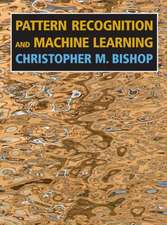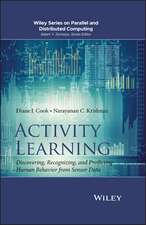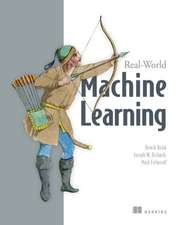Active Contours: The Application of Techniques from Graphics, Vision, Control Theory and Statistics to Visual Tracking of Shapes in Motion
Autor Andrew Blake, Michael Isarden Limba Engleză Paperback – 13 iun 2012
Preț: 337.64 lei
Preț vechi: 422.05 lei
-20% Nou
Puncte Express: 506
Preț estimativ în valută:
64.65€ • 66.62$ • 54.25£
64.65€ • 66.62$ • 54.25£
Carte tipărită la comandă
Livrare economică 22 februarie-08 martie
Preluare comenzi: 021 569.72.76
Specificații
ISBN-13: 9781447115571
ISBN-10: 1447115570
Pagini: 368
Ilustrații: XII, 352 p.
Dimensiuni: 191 x 235 x 19 mm
Greutate: 0.63 kg
Ediția:Softcover reprint of the original 1st ed. 1998
Editura: SPRINGER LONDON
Colecția Springer
Locul publicării:London, United Kingdom
ISBN-10: 1447115570
Pagini: 368
Ilustrații: XII, 352 p.
Dimensiuni: 191 x 235 x 19 mm
Greutate: 0.63 kg
Ediția:Softcover reprint of the original 1st ed. 1998
Editura: SPRINGER LONDON
Colecția Springer
Locul publicării:London, United Kingdom
Public țintă
ResearchDescriere
Active Contours deals with the analysis of moving images - a topic of growing importance within the computer graphics industry. In particular it is concerned with understanding, specifying and learning prior models of varying strength and applying them to dynamic contours. Its aim is to develop and analyse these modelling tools in depth and within a consistent framework.
Cuprins
1 Introduction.- 1.1 Organisation of the book.- 1.2 Applications.- 2 Active shape models.- 2.1 Snakes.- 2.2 Deformable templates.- 2.3 Dynamic contours.- I Geometrical Fundamentals.- 3 Spline curves.- 3.1 B-spline functions.- 3.2 Finite bases.- 3.3 Multiple knots.- 3.4 Norm and inner product for spline functions.- 3.5 B-spline parametric curves.- 3.6 Curves with vertices.- 3.7 Control vector.- 3.8 Norm for curves.- 3.9 Areas and moments.- 4 Shape-space models.- 4.1 Representing transformations in shape-space.- 4.2 The space of Euclidean similarities.- 4.3 Planar affine shape-space.- 4.4 Norms and moments in a shape-space.- 4.5 Perspective and weak perspective.- 4.6 Three-dimensional affine shape-space.- 4.7 Key-frames.- 4.8 Articulated motion.- 5 Image processing techniques for feature location.- 5.1 Linear scanning.- 5.2 Image filtering.- 5.3 Using colour.- 5.4 Correlation matching.- 5.5 Background subtraction.- 6 Fitting spline templates.- 6.1 Regularised matching.- 6.2 Normal displacement in curve fitting.- 6.3 Recursive solution of curve-fitting problems.- 6.4 Examples.- 7 Pose recovery.- 7.1 Calculating the pose of a planar object.- 7.2 Pose recovery for three-dimensional objects.- 7.3 Separation of rigid and non-rigid motion.- II Probabilistic Modelling.- 8 Probabilistic models of shape.- 8.1 Probability distributions over curves.- 8.2 Posterior distribution.- 8.3 Probabilistic modelling of image features.- 8.4 Validation gate.- 8.5 Learning the prior.- 8.6 Principal Components Analysis (PCA).- 9 Dynamical models.- 9.1 Some simple dynamical prior distributions.- 9.2 First-order Auto-regressive processes.- 9.3 Limitations of first-order dynamical models.- 9.4 Second-order dynamical models.- 9.5 Second-order AR processes in shape-space.- 9.6 Setting dynamical parameters.- 10 Dynamic contour tracking.- 10.1 Temporal fusion by Kaiman filter.- 10.2 Tracking performance.- 10.3 Choosing dynamical parameters.- 10.4 Case study.- 11 Learning motion.- 11.1 Learning one-dimensional dynamics.- 11.2 Learning AR process dynamics in shape-space.- 11.3 Dynamical modes.- 11.4 Performance of trained trackers.- 12 Non-Gaussian models and random sampling algorithms.- 12.1 Factored sampling.- 12.2 The CONDENSATION algorithm.- 12.3 An observation model.- 12.4 Applications of the CONDENSATION algorithm.- A Mathematical background.- A.1 Vectors and matrices.- A.2 B-spline basis functions.- A.3 Probability.- B Stochastic dynamical systems.- B.1 Continuous-time first-order dynamics.- B.2 Second-order dynamics in continuous time.- B.3 Accuracy of learning.- C Farther shape-space models.- C.1 Recursive synthesis of shape-spaces.- Glossary of notation.- Author Index.
Caracteristici
Provides the first consistent overview of this important and emerging area in book form * Contains a full-colour, 20 page section which illustrates 10 applications of the technology described * Examples and bibliographic notes are included after each chapter, and tutorial code will be made available on the WWW











